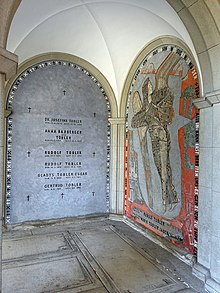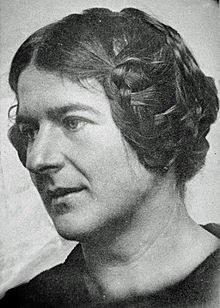Anna Maria Tobler
Anna Maria Tobler (born February 26, 1882 in Flüelen in the canton of Uri , † April 20, 1935 in Münsterlingen ) was a Swiss artist.
Life
Anna Tobler's parents were Rudolf Tobler (1852–1931) and Marie Tobler-Jauch (1858–1923). She grew up with her older sister Josephine, one of the first doctors in Lucerne (1879–1959) and her two younger brothers Rudolf (1884–1943) and Max (* 1886). Another brother, Wilhelm, died in childhood. Anna's father, Rudolf Tobler, was co-owner and director of the Bank Sebastian Crivelli & Comp., A major bank at the time with its headquarters in Altdorf and a bank in Lucerne . Shortly after Anna was born, the von Flüelen family (Canton Uri) moved to Lucerne.
Anna went to school there too. At the age of 16 she came to a monastery in Aigle for a year to learn the French language. She showed more and more talent and joy in painting . With difficulty she managed to break the resistance of her parents, especially that of her mother, and to obtain permission for artistic training.
Art education
Anna Tobler received her first artistic training at the Lucerne School of Applied Arts . In 1902 she attended the Zurich School of Applied Arts for several months as a student of the painter Hans Bachmann . In 1903 she continued her education in Munich . In addition to Paris , this city was of crucial importance for the training of Swiss painters.
In 1905/1906 Anna Tobler stayed in Paris for nine months. She was allowed to submit some of her youthful poems to the Nobel Prize winner for literature, Carl Spitteler, for review.
In 1907 she was forced to seek treatment in the Königsfelden psychiatric institution because of a severe depression . After almost a year, her condition returned to normal and she was able to return home. For further artistic training, she attended the Accademia Internationale di Belle Arti in Florence in 1910/11 , which was founded in 1907 by the Lucerne sculptor Joseph Zbinden and his wife. Tobler stood out because of her versatile talent. In Florence she met the painter August Babberger and Augusto Giacometti , who taught figurative painting there. A love affair developed between August Babberger and Anna Maria Tobler. On September 9, 1912, the two married in Stampa , where Augusto Giacometti lived, who was the best man.
Wilhelm Schäfer described Anna Babberger as “a delightful woman and an artist by her own grace. She messes up her pictures as much as possible to slowly fix them, her husband said. This order was all the more astonishing as it usually astonished us with a barely comprehensible disorder. "
After a short stay with relatives in Zurich, the artist couple moved to Frankfurt at Kettenhofweg 44 at the end of 1912 .
1914-1935

When the First World War broke out in 1914 , Anna and August Babberger stayed with Augusto Giacometti in Stampa. They traveled via Lucerne to Germany, where Babberger reported for military service, but was released from work because of his goiter . During the war years, the artist couple lived in Frankfurt and partly in Central Switzerland with Anna's sister, the doctor Josephine Tobler, in an attic under the roof at Hirschmattstrasse 11 in Lucerne. Anna brought the Lake Lucerne region closer to her husband and thereby laid the foundation for the Urner Kreis , an artist group that was later formed around August Babberger.
From 1916/1918 the Babberger-Tobler couple regularly spent the summer months on the Balmalp in the area of the Klausen Pass in a secluded hut that belonged to the hotel on the Klausen Pass.
At the beginning of 1924 Anna Babberger was able to show five flower pictures in a group exhibition at the Kunsthaus Zürich . She painted, was active as a writer and supported her husband in his artistic work. So she took over the execution of his tapestry designs . August Babberger, for his part, supported his wife in realizing her projects. In May 1926, for example, he staged the world premiere of their play Ein Frühlingsspiel with the master students of the art academy . In 1929 Anna Babberger took part in the exhibition “Badisches Kunstschaffen der Gegenwart” in the Städtische Kunsthalle Mannheim . In 1931 she exhibited at the Badischer Kunstverein.
After Heinrich Danioth , Erna Schillig , a native of Uri, also attended August Babberger's class for decorative painting and wall painting in Karlsruhe from 1927 and later became his master and private student. Around 1930 a love affair arose between Erna Schillig and August Babberger. In 1932 Babberger carried out two important projects with Schillig: the painting of the court chapel and the travel description from Lake Uri over the Klausen Pass with texts by Babberger and illustrations by Schillig. For Anna Babberger, not only the love affair with her husband, but also the artistic collaboration with him was called into question: her place as an artist at the artist's side had been taken by another woman.
The decline of the Crivelli bank, the economic foundation of their own family (the banker Rudolf Tobler), was also a burden. Another burden was the artistic hostility of the emerging National Socialism . As a result, the artistic circle of friends in Germany dissolved. All of this triggers fundamental existential fears in Anna Babberger and plunges her into a severe depression for the second time in her life, from which she no longer recovered.
Anna Babberger died in the early afternoon of April 20, 1935 in the Münsterlingen Psychiatric Clinic. She was buried in the family grave in the Friedental cemetery. In the year of her death, the Lucerne Art Museum honored Anna Babberger with a memorial exhibition and showed 29 pictures of her, as well as a portrait that August Babberger had painted of her.
plant
Anna Babberger was very versatile and used different expressions and artistic techniques. She was a poet, painter and textile designer. The motif of the seasons runs as a red thread through the entire work .
poetry
Only three poetic works can be proven with certainty. There are also references to three other works, which, however, have been lost:
- the poetry ribbon "A Spring Game"
- "The seasons picture books"
- four poems published in an anthology
- a small volume of poetry (lost)
- a collection of youth poems (lost)
- a collection of satirical poems (lost).
The four poems listed under 3 appeared in the anthology Arsenal: Poetry of German minor poets from the 16th to the 20th century .
Textile work
Anna Babberger appeared as a textile artist mainly in collaboration with her husband August Babberger. She took over the execution of the wall hangings designed by him.
painting
Despite Anna Babberger's versatility, the focus of her artistic work is on painting. Her painting style is shaped by impressionism , art nouveau and expressionism . Her work focuses on:
- the flower pictures in oil
- the reverse glass painting.
The glass painting takes in the work of Anna Babberger a special place. She developed her own style and thus achieved a certain importance: In the General Lexicon of Visual Artists , Anna Babberger, as August Babberger's wife, is only mentioned as a "reverse glass painter". This technique is also explicitly mentioned in the artist lexicon of Switzerland : «Reverse glass painting: allegories, flowers, still lifes.» In addition, Georg Staffelbach, in his story on Lucerne reverse glass painting, judges her reverse glass paintings as "striking and characteristic of their work." He describes Anna Babberger as groundbreaking for reverse glass painting in central Switzerland.
literature
- Andreas Gabelmann: August Babberger (1885–1936), life and work. LIT, Münster 2002.
- Wilhelm Schäfer: Lexicon of my fellow men. Unpublished typescript. Schäfer estate, literary archive of the Heinrich Heine Institute, Düsseldorf 1949, p. 7.
- Georg Staffelbach: History of Lucerne Reverse Glass Painting from the Beginnings to the Present. Schilling, Lucerne 1951.
- Gustav Noll: Arsenal: Poetry of German minor poets from the 16th to the 20th century. Propylaea, Berlin 1973.
- Babberger, August . In: Hans Vollmer (Hrsg.): General Lexicon of Fine Artists of the XX. Century. tape 1 : A-D . EA Seemann, Leipzig 1953, p. 85 .
- Eduard Plüss: Artist Lexicon of Switzerland, XX. Century. Huber, Frauenfeld 1958–1961.
- Dankmar Trier: Babberger-Tobler, Anna . In: General Artist Lexicon . The visual artists of all times and peoples (AKL). Volume 6, Saur, Munich a. a. 1992, ISBN 3-598-22746-9 , p. 96.
Web links
- Literature by and about Anna Maria Tobler in the catalog of the German National Library
- Babberger-Tobler, Anna. In: Sikart
- Anna Maria (Babberger-) Tobler in the online collection of the Kunstmuseum Luzern
| personal data | |
|---|---|
| SURNAME | Tobler, Anna Maria |
| ALTERNATIVE NAMES | Babberger-Tobler, Anna Maria |
| BRIEF DESCRIPTION | Swiss painter |
| DATE OF BIRTH | February 26, 1882 |
| PLACE OF BIRTH | Altdorf UR |
| DATE OF DEATH | April 20, 1935 |
| Place of death | Munsterlingen |

